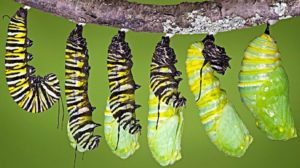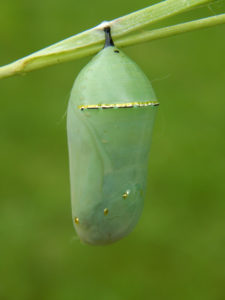After two weeks as a caterpillar, the monarch is ready to become an adult butterfly. The caterpillar stops eating and searches for a safe location to pupate. It forms a silk pad and “button” to hang the head down in a “J” shape, staying this way for about 14 hours. It then molts, revealing a pale green pupa in less than two minutes. The pupa transforms into a beautiful jade color with gold trim through a process known as the “Pupa Dance.”
While metamorphosis appears to have four distinct stages, continuous changes occur within the larva. Wings and other adult organs develop from tiny clusters of cells already present. By the time the larva pupates, major changes to the adult form have begun. During the pupal stage, this transformation is completed. Unlike many moths that spin cocoons, butterflies do not, and their pupa stage is called a chrysalis.
Chrysalis (Pupa) Metamorphosis

Chrysalis

Gender of Monarch Chrysalis

Determining the gender of the chrysalis requires keen eyes or a microscope. Surrounding the cremaster (the structure from which the chrysalis hangs). There are a pair of black dots next to the cremaster.
- If the monarch is a female, there will be a distinct line centered between the black dots.
- If the monarch is male, there will be a small dimple centered between the black dots.
